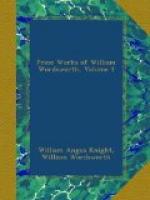To illustrate the relation which in my mind this ‘Pastor’ bore to the ‘Wanderer,’ and the resemblances between them, or rather the points of community in their nature, I likened one to an oak, and the other to a sycamore; and having here referred to this comparison, I need only add, I had no one individual in my mind, wishing rather to embody this idea than to break in upon the simplicity of it by traits of individual character, or of any peculiarity of opinion.
And now for a few words upon the scene where these interviews and conversations are supposed to occur.
The scene of the first book of the poem is, I must own, laid in a tract of country not sufficiently near to that which soon comes into view in the second book, to agree with the fact. All that relates to Margaret, and the ruined cottage, &c., was taken from observations made in the south-west of England, and certainly it would require more than seven-leagued boots to stretch in one morning from a common in Somersetshire, or Dorsetshire, to the heights of Furness Fells, and the deep valleys they embosom. For this dealing with space, I need make, I trust, no apology; but my friends may be amused by the truth.
In the poem, I suppose that the Pedlar and I ascended from a plain country up the vale of Langdale, and struck off a good way above the chapel to the western side of the Vale. We ascended the hill, and thence looked down upon the circular recess in which lies Blea Tarn, chosen by the ‘Solitary’ for his retreat. After we quit his cottage, passing over a low ridge, we descend into another Vale, that of Little Langdale, towards the head of which stands embowered, or partly shaded by yews and other trees, something between a cottage and a mansion, or gentleman’s house, such as they once were in this country. This I convert into the parsonage, and at the same time, and as by the waving of a magic wand, I turn the comparatively confined Vale of Langdale, its tarn, and the rude chapel which once adorned the valley, into the stately and comparatively spacious Vale of Grasmere and its ancient parish church; and upon the side of Loughrigg Fell, at the foot of the Lake, and looking down upon it and the whole Vale and its accompanying mountains, the ‘Pastor’ is supposed by me to stand, when at sunset he addresses his companions in words which I hope my readers may remember,[14] or I should not have taken the trouble of giving so much in detail the materials on which my mind actually worked.
[14] Excursion; book the last, near the conclusion.
Now for a few particulars of fact, respecting the persons whose stories are told or characters described by the different speakers. To Margaret I have already alluded. I will add here that the lines beginning,
‘She was a woman of a steady mind,’
and,
‘Live on earth a life of happiness,’
faithfully delineate, as far as they go, the character possessed in common by many women whom it has been my happiness to know in humble life; and that several of the most touching things which she is represented as saying and doing are taken from actual observation of the distresses and trials under which different persons were suffering, some of them strangers to me, and others daily under my notice.




